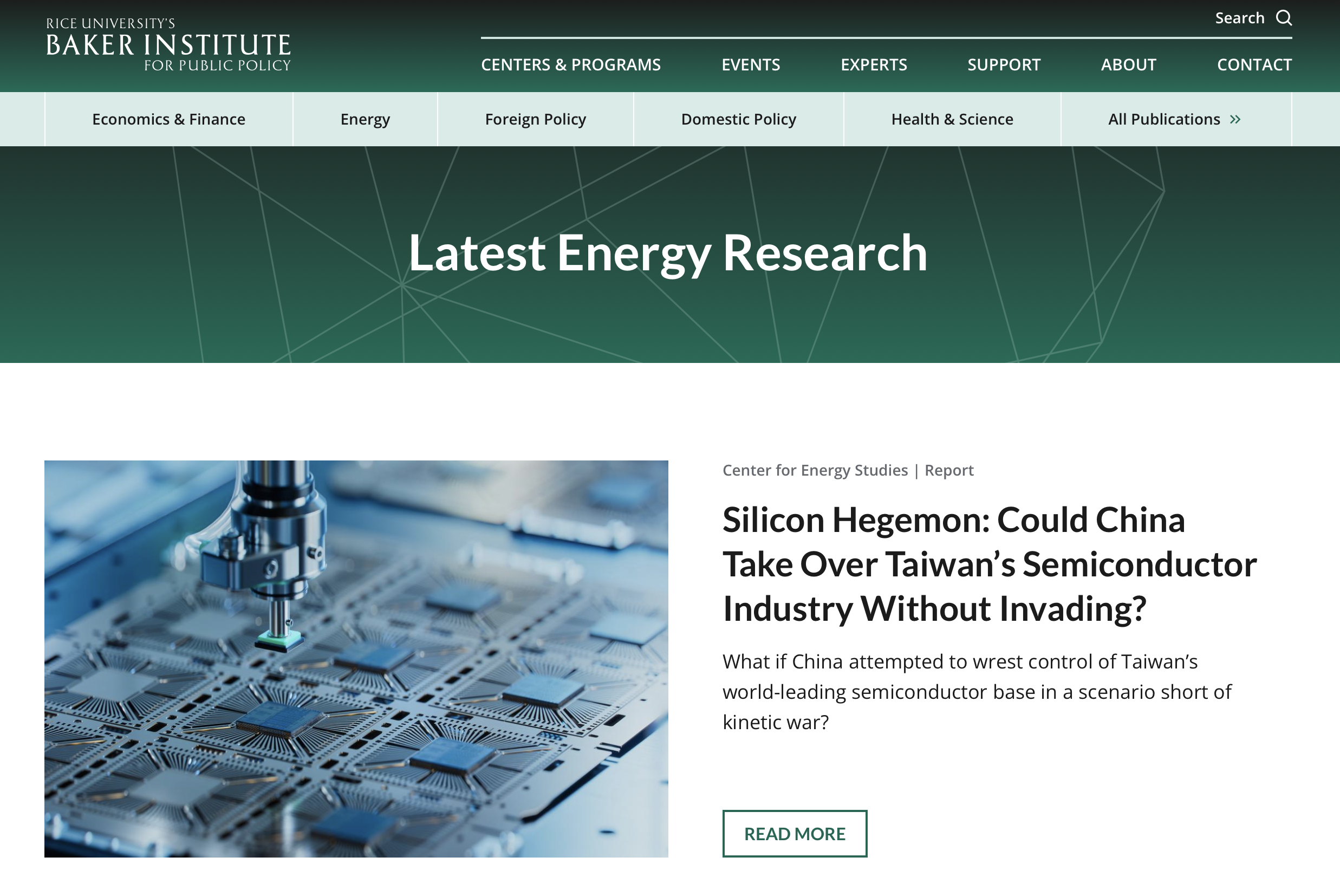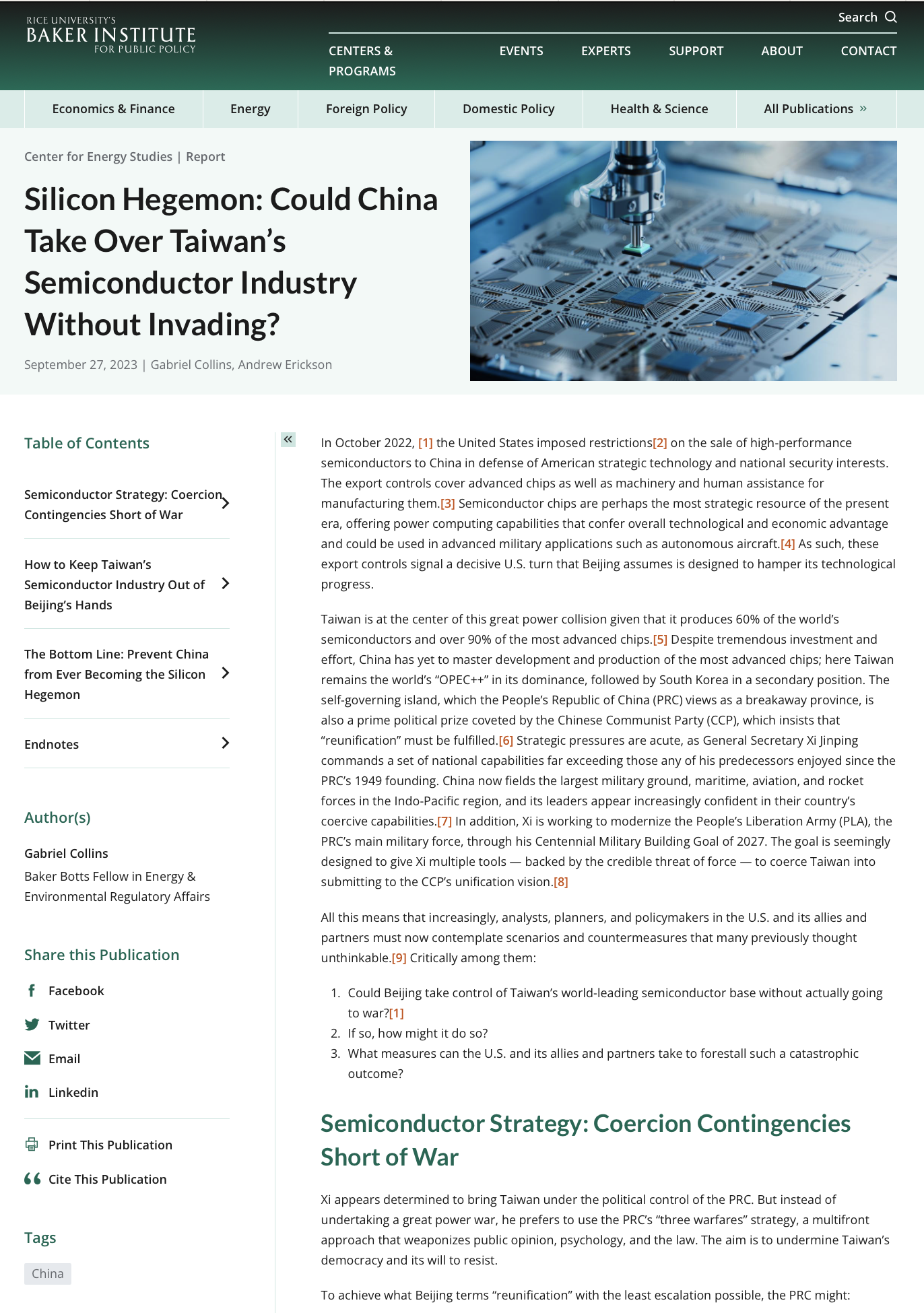Silicon Hegemon: Could China Take Over Taiwan’s Semiconductor Industry Without Invading?
Gabriel B. Collins and Andrew S. Erickson, Silicon Hegemon: Could China Take Over Taiwan’s Semiconductor Industry Without Invading? (Houston, TX: Baker Institute for Public Policy, Rice University, 27 September 2023).
The views expressed here are those of the authors alone, and do not represent the positions of any organization with which they are currently, or have been, affiliated.
In October 2022, [1] the United States imposed restrictions[2] on the sale of high-performance semiconductors to China in defense of American strategic technology and national security interests. The export controls cover advanced chips as well as machinery and human assistance for manufacturing them.[3] Semiconductor chips are perhaps the most strategic resource of the present era, offering power computing capabilities that confer overall technological and economic advantage and could be used in advanced military applications such as autonomous aircraft.[4] As such, these export controls signal a decisive U.S. turn that Beijing assumes is designed to hamper its technological progress.
Taiwan is at the center of this great power collision given that it produces 60% of the world’s semiconductors and over 90% of the most advanced chips.[5] Despite tremendous investment and effort, China has yet to master development and production of the most advanced chips; here Taiwan remains the world’s “OPEC++” in its dominance, followed by South Korea in a secondary position. The self-governing island, which the People’s Republic of China (PRC) views as a breakaway province, is also a prime political prize coveted by the Chinese Communist Party (CCP), which insists that “reunification” must be fulfilled.[6] Strategic pressures are acute, as General Secretary Xi Jinping commands a set of national capabilities far exceeding those any of his predecessors enjoyed since the PRC’s 1949 founding. China now fields the largest military ground, maritime, aviation, and rocket forces in the Indo-Pacific region, and its leaders appear increasingly confident in their country’s coercive capabilities.[7] In addition, Xi is working to modernize the People’s Liberation Army (PLA), the PRC’s main military force, through his Centennial Military Building Goal of 2027. The goal is seemingly designed to give Xi multiple tools — backed by the credible threat of force — to coerce Taiwan into submitting to the CCP’s unification vision.[8]
All this means that increasingly, analysts, planners, and policymakers in the U.S. and its allies and partners must now contemplate scenarios and countermeasures that many previously thought unthinkable.[9] Critically among them:
- Could Beijing take control of Taiwan’s world-leading semiconductor base without actually going to war?[1]
- If so, how might it do so?
- What measures can the U.S. and its allies and partners take to forestall such a catastrophic outcome? … … …
The Bottom Line: Prevent China from Ever Becoming the Silicon Hegemon
Over the past eight decades Asian growth has been a prime mover of the global economy — first in the “Asian Tigers” (Hong Kong, Singapore, South Korea, and Taiwan) and more recently in the PRC. It is crucial to protect the progress made over those 80 years of great power peace from eroding, or outright rupturing, as a result of the CCP’s revisionist impulses. American policy increasingly emphasizes containing those impulses, including in the tech space. But Washington does not seek regional domination in the way that the PRC under Xi likely would. While Beijing likely disagrees, eight decades of lived experience strongly suggest there is a place for both global titans to grow and prosper in an order that rejects conquest by force.
History shows that China grew into a quasi-superpower without annexing Taiwan or its superlative semiconductor industrial base. Yet the emotive commitment of the PRC under Xi to “reunify” Taiwan with the PRC means that the existing peaceful and prosperous order so painstakingly built from the ashes of World War II will not survive spontaneously. Given the risks involved, it is best to hold the line through this decade of maximum danger through deterrence and thereby prevent Xi from ever reopening such a disastrous Pandora’s Box. Ultimately, however, that increasingly precarious peace may need to be defended with military strength.
Washington’s approach must therefore anchor to the time-tested maxim of “si vis pacem, para bellum”: if you want peace, prepare for war. A lack of capacity or will to defend free maritime and air passage to and from Taiwan would open the doors to strategic catastrophe for the United States and its allies and partners. We need to think through the previously unthinkable and be ready to deter aggression — aiming to stop disaster before it can happen — and prevent China from ever becoming the silicon hegemon in the first place.
***
The authors wish to thank Chris Miller of Tufts University, Chris Sharman (CAPT-USN ret.), and Chris Bronk of the University of Houston for excellent critiques that helped make this a better report. Thanks are also due to several anonymous tech and finance-savvy reviewers whose feedback assisted enormously. Any errors in fact or analysis are the authors’ alone.







































